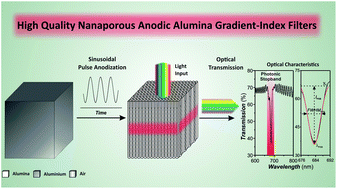Realization of high-quality optical nanoporous gradient-index filters by optimal combination of anodization conditions†
Abstract
High-quality nanoporous anodic alumina gradient-index filters (NAA-GIFs) are realized by sinusoidal pulse anodisation (SPA) of aluminum. A three-level factorial design of experiments is used to determine the effect of three critical anodization parameters –electrolyte temperature, concentration of the electrolyte and anodization time– on the quality of light control in these photonic crystal (PC) structures. Quantitative analysis of the effect of these anodization parameters on the quality of the characteristic photonic stopband (PSB) of NAA-GIFs reveals that all three anodization parameters and their respective combinations have statistically significant effects. However, anodization time is found to have the highest impact on the quality of light control in NAA-GIFs, followed by the electrolyte concentration and its temperature. Our findings demonstrate that NAA-GIFs fabricated under optimal conditions achieve an outstanding quality factor of ∼86 (i.e. ∼18% superior to that of other NAA-based PCs reported in the literature). This study provides new insight into optimal anodization conditions to fabricate high-quality NAA-based PC structures, opening new exciting opportunities to integrate these nanoporous PCs as platform materials for light-based technologies requiring a precise control over photons such as ultra-sensitive optical sensors and biosensors, photocatalysts for green energy generation and environmental remediation, optical encoding and lasing.



 Please wait while we load your content...
Please wait while we load your content...